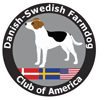K9 Nose Work® 101
by Sally H. Frankel
August, 2011
Want to feel the thrill of watching your dog excel at using one of Mother Nature's most phenomenal survival tools? Want to learn to read your dog's body language when he has found the item for which he was searching? Want to bond with your dog as you both stimulate your minds? Then K9 Nose Work® is the sport for you and your BFF!
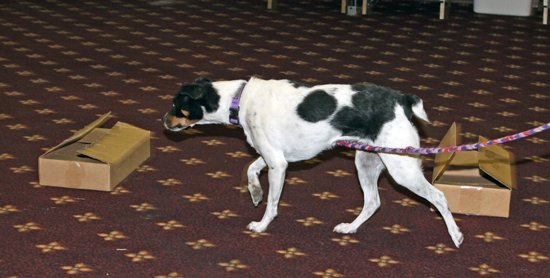 |
| Suzie Stub-butt searching containers. Photographer: Marganna King, 11/13/2010 |
I started learning K9 Nose Work® with both my Danish/Swedish Farmdogs about eight months ago. It took guts to feel so inadequate and stupid while I learned how to read my dogs. But with an excellent trainer, a lot of practice, two very smart dogs, and a lot of laughter we are beginning to enjoy a bonding experience like no other. The joy of working as a team with your dog is an amazing experience. The dogs love doing what is their natural instinct; It stimulates their minds and is very rewarding for both of us.
I became interested in K9 Nose Work® because I wanted something that I could continue to do with my dogs for many years. The ugly monster of old age is rapidly taking over my body and I find that the active sport of Flyball is beginning to take its toll. I first learned about K9 Nose Work® from an article in the Whole Dog Journal. I found Ramona Audette, CNWI, a local K9 Nose Work® trainer, and enrolled in her classes at the California Academy of Dog Behavior. Ramona volunteered to introduce K9 Nose Work® to the Danish/Swedish Farmdogs at the 2010 National Breed Specialty. Some of the pictures in this article are from that introduction event.
This is a story of what I have experienced as a beginner. I hope it will be entertaining and inspire you to enjoy working with your dog. I guarantee it will be a rewarding adventure and give you the opportunity to be amazed at the power of your dog's nose.
What is K9 Nose Work®?
K9 Nose Work® is one of the newest canine sports. It started a little over two years ago; created and sanctioned by the National Association of Canine Scent Work, LLC® (NACSW™). It was inspired by the training methodology of canine detection. You may have heard it called nose work, scent work, Fun K9 Nose Work®, or search work. It is the activity of a dog using its nose to locate a specific scent or odor. The training is similar to the way dogs are trained for Search and Rescue (SAR) and security drug and bomb detection.
How to begin
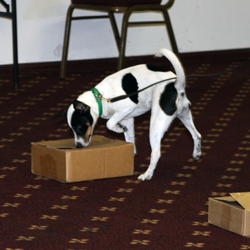 |
| Box drill is the first step in learning K9 Nose Work®. Tabatha has a nose for this kind of work. Photographer: Marganna King, 11/13/2010 |
My first class took place at a dog grooming shop. It was after hours when the shop was closed. The class consisted of a confident Corgi with an experienced handler, a young lumbering English Mastiff, two Papillons, a very shy and skittish rescue German Short Hair Pointer and my two Danish/Swedish Farmdogs (Anna and Luke). This cross section of breeds demonstrates that just about any dog can do K9 Nose Work®. The Corgi came from a family of three dogs that all compete in various canine obedience and sports activities. The Mastiff lived with a Vet Tech. Although he was a young pup, he was used to going places and being with other people and dogs. The Pointer was submissive and fearful. She was a rescue dog learning nose work in hopes of giving her more confidence. The Papillons were show dogs and family pets that enjoy doing things with their owners.
Ramona gave us a small lecture about K9 Nose Work® and told us that it is very important that we identify the one thing that our dog recognizes as the ultimate reward. We must be quick to reward at the spot where the odor is located. Knowing how excited Luke and Anna are about tugging I thought that I had it nailed. I brought with me several toys, tugs and just as a last resort some treats. Boy was I way off base! When it was my turn both my dogs let me know that for this game they wanted food!
 |
| Blondie gets her reward at the source of odor Photographer: Marganna King, 11/13/2010 |
We started learning to find the odor by using cardboard boxes. At the very beginning we put some of the dog's treats in a box. We placed the box with about eight or nine empty opened boxes on the floor. The dogs had to locate the box with the treats and then we would reward the dogs for distinguishing it from the other boxes. Rewarding the dog near the odor encourages the dogs to recognize the odor source. The box with the treats was marked on the outside to help us reward the dog as soon as he located it. At an odor test and in a trial the handler never knows where the odor is hidden. The handler must rely on the dog to show the location of the source of odor.
The box drills are continued throughout the entire sport. They are just one of the four elements (searches) of a trial.
How to introduce the Odor
Once our dogs learned to identify the box with food we started adding odor to the box. Birch was the first one we used. Once the dogs learned to completely identify the Birch odor we moved on to the Anise and then Clove.
Note: It is very important to keep the odor boxes isolated and sealed from the empty containers (boxes). Odor lingers for a very long time and contaminates the search area confusing the dog's search.
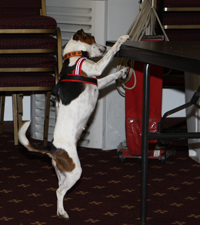 |
| Nellie follows her nose in the direction of the odor source Photographer: Marganna King, 11/13/2010 |
How Do We Progress to Other Elements?
At practice we moved the boxes to new locations. We practiced with the boxes both indoors and outdoors in order to get the dogs conditioned to searching in any environment. Practicing in the same location all the time hinders the dog from being comfortable in new areas. Trials are always at a new location so conditioning the dog to work anywhere works to your advantage. -- If you were training a Search and Rescue dog you would try to introduce them to all sorts of places and conditions. It is the same with K9 Nose Work®.
In addition to moving locations of the hides we also changed the elevations. Some times the hides were on the ground, in a bookcase, on a chair pushed under the table, or four feet above the ground on a counter. Dogs have to be able to indicate where the source of odor is hidden, even if they cannot reach it.After a while we stopped using the boxes and placed the odor into small containers that could be placed anywhere. Small tins with magnets allowed us to place the odor at various levels and on metal surfaces. -- The small black plastic tube at the end of the poop-bag rolls works well with Q-tips dipped in odor. Hides can be placed anywhere; inside, outside, on vehicles, and in boxes.
 |
| Nellie climbs on the table to locate the hide. Photographer: Marganna King, 11/13/2010 |
In NW2 and NW3 trials containers can be anything that contains something. Some of the items I have seen used are luggage, boxes, eyeglass cases, piggy banks, coffee tins, dog equipment bags, and even a 2010 Danish/Swedish Farmdog National Breed Specialty tote.
Note: I have learned so much from being in a class with a K9 Nose Work® trained instructor. Having multiple places to train and practice plus being able to watch other dogs was invaluable! If you can take a class you will learn faster and not make the mistakes beginners usually do. I started out just wanting something to do with my dogs and after I started learning more I found that I wanted to earn K9NW™ titles. This could happen to you. It is so much easier to train right the first time. Re-training and unlearning is very hard for both humans and dogs.
You can locate trained k9 Nose Work® instructors in your area here.
How do I know my dog has found the Source of Odor?
While practicing it is always a good idea to have someone take video of you and your dog. In class we always have someone video the searches. I had to be told by an observer the signs my dogs were giving me when they alert to the source of odor. The more I work with my dogs the more familiar I become in recognizing the difference in body language from finding the odor and the excitement of locating the source. I am now beginning to recognize the difference of the search posture and sounds my dogs make when they are in odor from what they do when they are just sniffing the environment such as other dogs, critters and food.
All dogs give their own personal alert signals. One of my dogs makes a very quick glance at me while the other dog stops in his tracks, turns and looks at me. In competition the handler has to know the location of the source even when he cannot see it. The handler must rely on the dog to show him. So learning your dog's body language will help you to determin the place the dog is indicating as the source of odor. The more you observe and practice with your dog the more you will learn to trust your dog's alert.
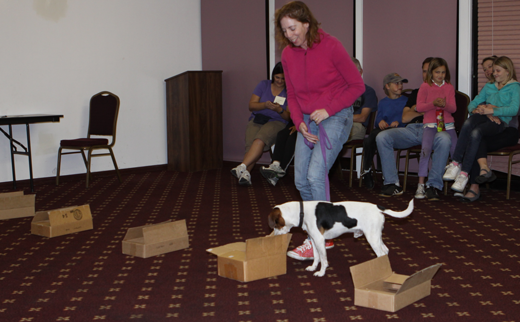 |
Photographer: Marganna King, 11/13/2010 |
Odor Tests and Titles
I entered my first trial with Luke in August of this year. I was very surprised to learn that very few people earn their NW1 title at their first trial. Out of the twenty-six entries only two titles were earned. I believe that this was not the first trial for both titled dogs. One woman I spoke with told me that this was her sixth trial and she still didn't pass. Now don't get discourage; she has never taken a class, does not have a training group and ... she does not have a Danish/Swedish Farmdog - Tee hee!
The NACSW™ is keeping statistics on testing and trial entries. At the time of this article, less than 10% of the dogs earn titles at their first trial. Many failures are due to either handler's nerves or the dog not being able to focus in a new environment. From my limited observation I see that a lot of handlers try to lead their dogs to where they think the hide may be located. The people that learn to trust their dogs and follow them to odor are more successful. They seem to have more fun as well.
Titles can be earned for K9 Nose Work® like most canine sports. There are very specific rules and procedures to earn them. Trials become harder as the titles increase. A brief outline of trial requirements is listed below. The complete set of rules can be found on the National Association of Canine Scent Work, LLC® (NACSW™) Web site.
K9 Nose Work® Titles
NW1 Proficient in Birch and requires one qualifying trial of 100 points score with no more than 3 faults. All hides must be located. There will be one hide per element.
more detail ...
NW2 Proficient in two odors, Birch and Anise. NW2 requires one qualifying trial of 100 points score with no more than 3 faults. All hides must be located. There will be one or two hides per element. Birch, Anise, or a combination of both odors may be used in each element. more detail ...
NW3 Proficient in three odors, Birch, Anise, and Clove. NW3 requires one qualifying trial of 100 points score with no more than 3 faults. All hides must be located and all calls must be made. There may be one two, or three hides per element. Birch, Anise, clove, or a combination of odors may be used in each element. In the Interior search there may be one area with no odor. The handler must declare it "clear". The number of hides in each element will not be stated. more detail ...
What is an Odor Recognition Test (ORT)?
The first thing you must do to compete in a K9 Nose Work® trial is to pass a test that confirms that your dog can recognize a specific odor. There are three odors used for K9 Nose Work® trials. They are Birch, Anise, and Clove. The dogs must pass an Odor Recognition Tests (ORT) for each of the specific odors. The ORT odors can be passed in any order; however, the Birch ORT must be passed before the dog can compete in a trial.
The ORT is a box drill type of exercise. Twelve identical closed cardboard boxes are set up in a pattern of one or two rows with each box a minimum distance of 48" apart. Only one box will contain the odor. The dog must locate the correct box and give the handler a sign. When the handler receives the cue from the dog the handler says, "Alert" to the judge. If the judge confirms the dog passes the test and the handler can reward the dog for identifying the box. The time limit for finding the odor is three minutes. If the handler alerted on the wrong box the test stops and the dog does not pass. If the dog does not find the odor in the time period it will not pass.
Trial Odors
Birch – Required for NW1 eligibility
Birch and Anise – Required for NW2 eligibility
Birch, Anis and Clove – Required for NW3 eligibility
What is a Trial?
The official K9 Nose Work® trials are sanctioned by NACSW™. There are three levels of trials, NW1, NW2, and NW3. Before you can compete in a trial the dog must be at least six months old and appear healthy on trial date. The dog must be current on all vaccinations required by law. The minimum age requirement for handlers is thirteen (There is no proof of vaccination requirement for handlers - Tee hee!).
The following are the elements that must be passed for all titles. Each of the elements are worth 25 points for a total possible 100 points overall. There is maximum time limit set for each element. That time limit for the search cannot be exceeded.
Note: For most trials, the time limit for each element is generally five minutes or less.
- Container Search (25 points for passing)
- Exterior Area Search (25 points for passing)
- Interior Building Search (25 points for passing)
- Vehicle Search (25 points for passing)
What are the Trial Elements?
Container Search is similar to the box drill used for the ORT. The search must be on-leash.
NW1 – 15 to 20 boxes set in any pattern. The boxes can be any shape or size. Only one box will contain the Birch odor.
NW2 – Containers and/or luggage (or combination thereof) set in any pattern. Multiple hides can be used with Birch, Anise, or a combination of the two orders. Distractor odors, such as food, toys, and animal smells and be hidden within the containers.
NW3 – Containers and/or luggage (or combination thereof) set in any pattern. Multiple hides can be used with Birch, Anise, Clove, or any combination of the three orders. Distractor odors, such as food, toys, and animal smells and be hidden within the containers.
Exterior Area Search can include the exterior of a building, a parking lot, grassy field, courtyard, etc. It is very difficult because of the many distractors and smells. The search area and search time limit will be determined on a number of factors including, size, weather conditions, complexity, distractors and title level. The search may have on and off-leash areas, depending on the particular trial requirements
Interior Building Search may include from one to three search areas depending on the title level. These are typically room-sized environments such as a kitchen, bathroom, conference room, office, or warehouse space. The search may have on and off-leash areas, depending on the particular trial requirements
Vehicle Search may have three to five vehicles in the search, depending on the title level. Any type of vehicle may be used (car, motorcycle, truck, trailer, semi, etc). Handlers must determine which vehicles contain the hide and specific location of that hide. The difficulty of this type of search is to pinpoint the location as the odor is likely moving around and below the exterior of the vehicle and/or bouncing among vehicles. Handlers must help their dogs work to the source of the target odor before committing to an alert. Handlers may be assessed a fault if their dog excessively paws or damages the vehicle at the judge’s discretion. The handler will never need to open a vehicle door for their dog to locate the hide.
K9 Nose Work® Resources
Find and Instructor in your area
K9 Nose Work® is rapidly growing in all parts of the country. You can fine certified instructors in most states. Click here for an up to date listing by State. Not all regions have instructors who have completed the certification process. However, many people in your area are enrolled in the instructor program and have demonstrated their commitment to learning how to teach K9 Nose Work® as developed by the founders of the sport. These teachers will be designated as ANWI™ which stands for Associate K9 Nose Work® Instructor. A listing of both types of instructors can be found here:
http://nacsw.net/certifiedinstructors.php.
Odor Recognition Test (ORT)
For a complete and up to date listing of all ORT dates and locations go here:
http://nacsw.net/nacsweventcalendar.html
K9 Nose Work® Trials
For a complete and up to date listing of all Trial dates and locations go here:
http://nacsw.net/nacsweventcalendar.html
For trial results and pictures go here: http://nacsw.net/trialphotosresults.html
K9 Nose Work® Supplies
To locate a source for K9 Nose Work® kits and oils click here: http://nacsw.net/targetodors.html
NACSW™ Membership
To join NACSW™ click here
Farmdogs that Participate in K9 Nose Work®
|
|
|
|
1 Dogs that are registered with NACSW™ and have tested in a NACSW™ ORT.
2 Dogs that have competed in a NACSW™ trial.
